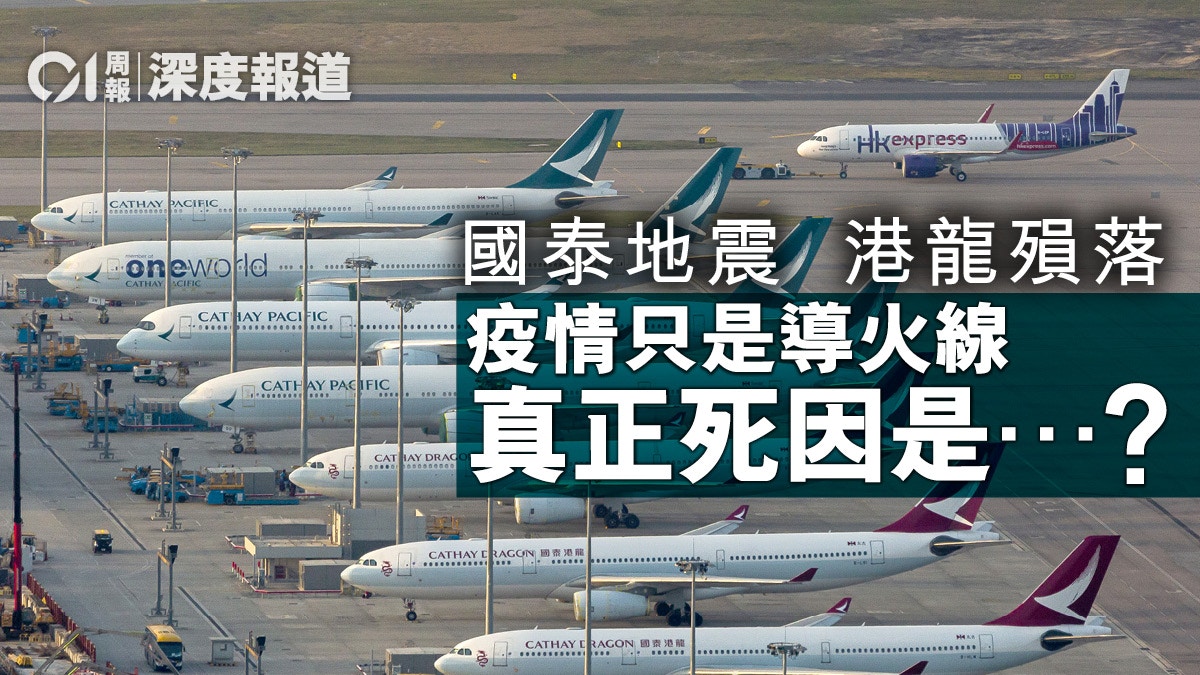weekly
Written by: Hao Ziyu
2020-10-26 22:41
Last update date: 2020-10-27 11:37
Cathay Pacific Airways, which is in deep operational crisis due to the new crown pneumonia epidemic, announced last Wednesday (October 21) that it will cut 8,500 jobs worldwide, including 5,300 employees in Hong Kong, and immediately cease operations in Hong Kong for 35 years. Dragonair.
This is not only more disastrous than the earlier circulated cut of 1,000 people, but also the largest layoff in the aviation industry in East Asia during the epidemic. It has attracted the attention of the whole Hong Kong and the world. What happened to Cathay Pacific?
Three feet of freezing, not a day’s cold, this "major earthquake" was not entirely due to the epidemic, because this veteran airline with a history of more than 74 years has not only failed to truly develop itself based on Hong Kong, but has also retained the British conservative for a long time. The company’s corporate culture cannot be flexibly challenged in the rapidly changing airspace competition in recent years.
"Lessons from Cathay Pacific, Hong Kong in Miniature" Series No. 4
Cathay Pacific, a subsidiary of the veteran British chaebol Swire Group, is based in Hong Kong and is one of the world's largest airlines. It has an excellent aviation safety record, a strong European and American route network, superior air and ground service levels, and high-quality ground transit efficiency. And so on, become a role model for global airlines.
However, Cathay Pacific has gradually declined in the past decade or so-when global aviation industry demand fell due to soaring oil prices in 2008, Cathay Pacific was also severely impacted, with losses as high as 8.558 billion yuan; to the sudden emergence of neighboring airlines, regional aviation competitions In a fierce 2016, Cathay Pacific once again recorded a loss of 575 million yuan. The next year, a major restructuring plan to lay off 600 Hong Kong employees was required. Last year’s anti-amendment turmoil led to a sharp drop in visitors to Hong Kong. Cathay Pacific, which was involved in political disputes, naturally bore the brunt. The annual profit fell by more than 10 billion yuan. This year, it was hit hard by the new crown pneumonia epidemic. In the first half of the year alone, it lost 9.865 billion yuan, although the SAR government directly injected 27.3 billion yuan in July to turn the tide and make it hold shares. 6.08%, and provided 680 million yuan in salary subsidy through the "Ensure Employment" program, but Cathay Pacific seems unable to recover.
Regarding Cathay Pacific’s governance culture and business strategy, there are three main reasons for its gradual loss of competitiveness: First, it is deeply affected by the culture of keeping the industry, and in the face of fierce competition, it still has an afterthought and failed to develop a more advantageous high Quality products are used to boost market share; secondly, market protection strategies have always been adopted, and frequent actions have been taken to hinder the development of competitors in Hong Kong. Even if Dragonair, which mainly expands high-quality inland routes, is taken as its own, it has never seriously clarified the two. Positioning, so that it lost its advantage in the rise of low-cost airlines; finally, although Cathay Pacific has taken root in Hong Kong since 1946, it has never really focused on Hong Kong’s interests and planned long-term development hand in hand with Hong Kong. It appears to be Hong Kong. The coat, but the inside is still an Englishman.
Cathay Pacific has gradually declined in the past decade-when global aviation industry demand fell due to soaring oil prices in 2008, Cathay Pacific was also severely affected, with a loss of 8.558 billion yuan.
(Data Picture / Photo by Yu Junliang)
The corporate culture is conservative and backward in the face of competition
Yuan Zhile, deputy director of the Aviation Policy Research Center of the Chinese University of Hong Kong, told "Hong Kong 01" that Cathay Pacific still retains the management culture of the British company and is relatively conservative. It is embodied in strict and high standards in employee training. It may be an advantage, but it is constantly in the market. In the transformation, its reaction ability appears to lag much behind.
He took the self-rescue of the aviation industry during the current epidemic as an example, and pointed out that many airlines have already used different methods to reduce the impact of the plunge in passenger flow. For example, Korean Air in South Korea and Evergreen Airlines in Taiwan have vigorously developed cargo transportation, and their business has not seen heavy losses. , And even have a certain growth; and some time after Singapore’s airlines launched "local travel", Hong Kong Express has just launched the "tour around Hong Kong" project.
"From these examples we can see the difference between Cathay Pacific's adaptability to new ideas and other airlines." He pointed out the pain of Cathay Pacific's corporate culture, but the examples are far more than the present.
The past glory of Cathay Pacific is actually related to the special status of Hong Kong.
In the 1990s, when the Chinese mainland accelerated the pace of reform and opening up, Hong Kong, as the "Four Asian Little Dragons", carried the halo of the world's largest free trade port, and naturally became a bridge and hub between China and the West.
At that time, Cathay Pacific flourished for a while with two major "home routes", one specifically referred to the passenger route between Europe and Oceania via the Eastern Hemisphere, the "Kangaroo Route"-"Europe-Hong Kong-Australia"; the other was called the "Golden Route" , Namely "Mainland-Hong Kong-Taiwan".
However, with the rise of the aviation industry in the Middle East, Emirates, Qatar Airways and Etihad Airways, as the "big three" among them, have developed their own "Kangaroo Routes". A piece of the pie, its strong capital, huge capacity, high passenger plane comfort, low detour rate and other advantages, robbed Cathay Pacific from the limelight; in addition, China Southern Airlines has also entered the "Kangaroo Route" market, making Cathay Pacific the "pillar" "At stake.
However, Cathay Pacific, facing challenges, did not actively change its strategy like other airlines, opening up new routes to deal with the losses of the "Kangaroo Route".
On the other hand, when there was no direct flight between Taiwan and the mainland, Hong Kong and Macau became a transit point between the two sides of the strait. With the changes in cross-strait policies, Taiwan gradually opened the mainland provinces and cities to Taiwan in 2008, and opened up free travel in 2011. This greatly weakened the role of Hong Kong and Macau as a transit point when the two sides of the strait were unable to fly directly. This dealt a heavy blow to Cathay Pacific’s "golden route". As a result, Dragonair, whose main inland line, lost a large number of inland transit flights to Taiwan. Customer source.
If Cathay Pacific were able to respond in a timely manner and let Dragonair focus on the second and third tier cities in the Mainland to transit international routes in Hong Kong, the two pillars would not be completely hollowed out.
After low-cost airlines became popular, Cathay Pacific insisted on "high-end routes and high-quality services" and refused to participate in the low-cost airline market. It was a lost opportunity to seize the market. It was not until low-cost airlines became an essential option for global airlines that Cathay Pacific acquired Hong Kong Express last year.
Dragonair is neither Cathay Pacific’s main “high-end international line” nor a low-cost airline line. It is just caught in the middle and has no strategic advantage.
(Profile picture)
Adopting market protection strategy, Dragonair's positioning is ambiguous
Full-service airlines, which we often call traditional airlines, mainly classify fares by class, provide various services such as catering and baggage consignment, emphasizing high-quality service and journey experience.
Low-cost airlines, also known as low-cost airlines, aim at short-range flights and save a lot of costs such as on-board services, so the price is relatively low.
The emergence of low-cost airlines has not only made traveling abroad no longer an extravagant activity, it has also become a general means of transportation in many countries.
Yuan Zhile believes that Cathay Pacific itself is a mature airline, which is mainly based on the image of a hub airline to gain competitiveness. Its profit sources are mainly long-distance and business travelers. It fails to pay attention to the low-cost airline. Therefore, it did not acquire low-cost airlines until last year. .
So, what role does Dragonair play in Cathay Pacific?
In 2006, Cathay Pacific spent 8.22 billion yuan to fully acquire Dragonair. Because Dragonair has a solid position in Hong Kong, its brand even enjoys a good reputation in the mainland. The acquisition at that time was also known as "Dragonair will marry Cathay Pacific."
However, this acquisition did not bring about a strong combination of "1+1>2", on the contrary, Dragonair has increasingly lost its position.
After acquiring Hong Kong Express last year, Cathay Pacific has three teams - Cathay Pacific Airways is responsible for long-distance international routes, Dragonair is responsible for mainland routes, and Hong Kong Express still exists as a low-cost airline.
In response, Yuan Zhile said: "Cathay Pacific’s previous arrangements are very rare. The average airline has a full-service airline to attract long-distance business travelers, plus a low-cost airline to compete with other low-cost airline brands── Because there are only long-haul airlines, it is difficult to compare and compete with low-cost airlines. In many cases, low-cost airlines will attract customers from full-service airlines, so large airlines will establish another low-cost airline. But Cathay Pacific has two full-service airlines. ── Cathay Pacific and Dragonair."
Dragonair is neither Cathay Pacific’s main “high-end international line” nor a low-cost airline line. It is just caught in the middle and has no strategic advantage.
Acquisitions are easy and difficult to move forward. The failure to set a clear market positioning for Dragonair has made it gradually be used by Bay Area Airports in the Mainland, especially Shenzhen Airport adjacent to Hong Kong, and has fallen into a state of sacrifice today. I can only regret "marrying the wrong person" back then.
Taking advantage of Hong Kong's advantages, Cathay Pacific can position its international hub as its profitable position. Why didn't it try to plan Hong Kong as a low-cost airline hub as early as when low-cost airlines emerged, which would not only reduce the loss of international airlines' market share, but also develop a new model? ?
Cathay Pacific announced its restructuring plan on October 21, cutting 8,500 jobs worldwide, including 5,300 employees in Hong Kong, and Cathay Dragon Airways ceased operations with immediate effect.
(Data Picture/Photo by Zhang Haowei)
Monopolize Hong Kong's interests and resources, not Hong Kong-based development
Although there are some competitors one after another, there is no doubt that Cathay Pacific has a dominant position in Hong Kong.
Of its 33,000 employees worldwide, more than 80%, or about 27,600, are Hong Kong employees.
The slashing of 5,300 local jobs this time undoubtedly made the unemployment situation in Hong Kong worse. Just one day before this announcement, the Hong Kong government announced that the unemployment rate had risen to 6.4%. The highest number in the year.
However, in view of Dragonair's ambiguous market positioning and its relatively high cost compared to low-cost airlines, the suspension may be regarded as a helpless move to stop bleeding.
However, according to Cathay Pacific's 2019 annual report, among its 18,000 aircrews, those with an annual salary of less than 1 million yuan accounted for a larger proportion, more than 3,000 people with an annual salary of more than 1 million yuan, and six people with an annual salary of more than 5 million yuan.
Such labor disparity between the rich and the poor is also reflected in the foreign and local pilots.
Taking a pilot with an average monthly income of about 60,000 yuan as an example, Cathay Pacific employs about 4,000 pilots in total, that is, Cathay Pacific needs to pay pilots a monthly salary of about 240 million yuan.
Among these 4,000 pilots, about 80 are foreign pilots, and Hong Kong people account for less than 20%. That is to say, only 48 million yuan can go to local pilots every month.
Moreover, Cathay Pacific employees in Hong Kong are mostly engaged in relatively low-paid service or maintenance jobs, such as thousands of cabin service positions with an average monthly salary of only about 16,000 yuan. On the day when the layoffs were announced, Cathay Pacific Air Service Staff Association Chairman Wang Simin spoke to reporters after meeting with senior officials. Said that Cathay Pacific headquarters will retrench 2,000 flight attendants.
According to wireless news reports before the layoffs, except for cabin attendants who were in the "severe disaster area," the rest of the laid-off staff were mostly ground handling, logistics support and pilots.
Cathay Pacific has "broken his arm." Whether it can stop the bleeding is still unknown. The Hong Kong government must learn from it and learn from it.
(Profile picture)
However, this Hong Kong’s dominated airline received an extraordinary capital injection of 27.3 billion yuan from the Hong Kong government more than three months ago. It also received nearly 700 million yuan in salary subsidies during the first round of the "Ensure Jobs" plan-taking local taxpayers. For the money, it is necessary to put the interests of local employees in the enterprise first, which is also beyond dispute.
However, those who are favored are always confident. Although Cathay Pacific enjoys exclusive and exclusive status in Hong Kong and has received huge funding from the Hong Kong government, it ranges from the pilot’s "different pay for equal work" to the abandonment of low-paid grassroots jobs in Hong Kong during layoffs. It seems that this company has never regarded the "Hong Kong standard" as the same thing.
Regardless of local interests, coupled with the above-mentioned stubbornness, the attempt to "response to all changes" and the repeated mistakes in decision-making and positioning, these "stubborn illnesses" have pushed Cathay into the abyss step by step.
The above-mentioned "stubborn diseases" seem to be very familiar-isn't the SAR government also like this?
Blindly thinking that one's own status is unshakable, so stubbornly conservative, not enterprising, and never thinking about the future based on the interests of Hong Kong people... Cathay Pacific has "broken its arms". Whether the bleeding can be stopped is still unknown. The Hong Kong government must take warning. Lesson learned from pain.
[Cathay Pacific Capital Injection.
In-depth] The government wants to save Cathay Pacific but also saves the future of the aviation industry
[Cathay Pacific Capital Injection.
In-depth] Reflections on the future of aviation industry integration of Hong Kong, Shenzhen, Zhuhai and Macao airports may become a miracle medicine
[Cathay Pacific Capital Injection.
Depth] To paint a blueprint for the aviation industry, localization of pilots must be implemented
[01 Weekly Editorial] To know how to save Cathay Pacific, we must know how to revitalize the industry
Cathay Pacific layoffs | Hong Kong’s “only son” in the aviation industry should no longer be “doted”
Unemployment rate soaring Cathay Pacific layoffs relief measures urgent
Cathay Pacific layoffs Dragonair suspends operations in Hong Kong's aviation industry but cannot shrink
[Cathay Pacific layoffs] The government should create more types of jobs and job opportunities
The above is excerpted from the 237th issue of "Hong Kong 01" Weekly (October 27, 2020) "What happened to Cathay Pacific in the 35 years of Hong Kong Dragon's fall?" ". If you want to read the full text, please
click here to
sample the weekly newsletter and browse more in-depth reports.
Selected content of 237 issue of "Hong Kong 01" Weekly News:
[Cover image] Cathay Pacific learned that Hong Kong's epitome is time to reorganize its aviation industry planning
What is wrong with Hong Kong's governance?
The government plans to set up factories in Hong Kong
Presidential election final debate: Trump missed the opportunity, Biden won
Battery technology advances into the "electric age"
London Experience Urban Agriculture: Enclosure planting becomes a trend
Witness the animal carcasses spreading across the wild, like purgatory cruelty to animals. Rescue is valuable!
Ransomware attacks multiply network security and face new threats
Cathay Pacific Airways, Cathay Pacific layoffs, Dragonair, Hong Kong aviation industry, airline in-depth report 01 Weekly



/cloudfront-eu-central-1.images.arcpublishing.com/prisa/MQ62V24GUVHPRDNYKHSOUZO7ZE.jpg)











